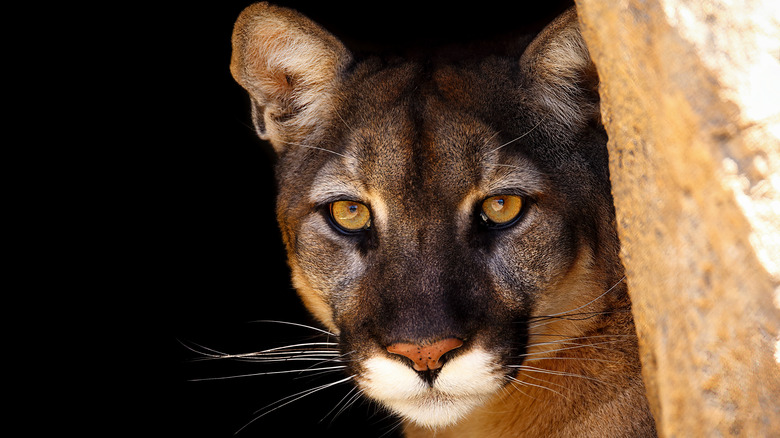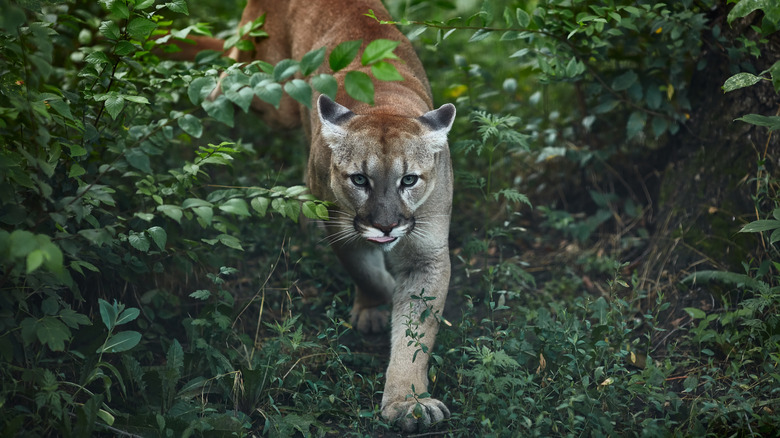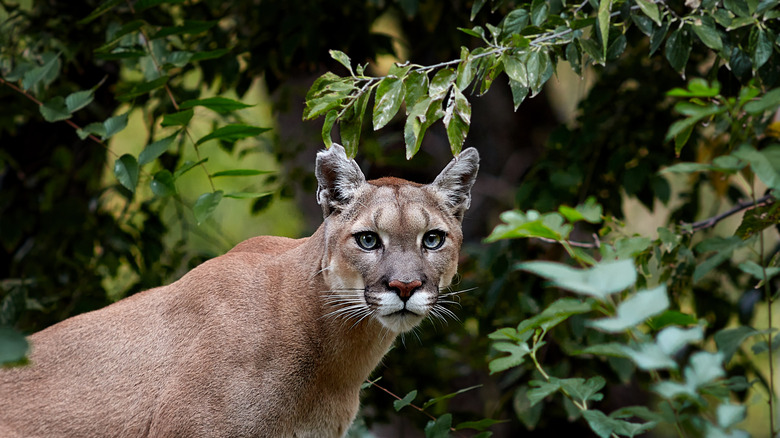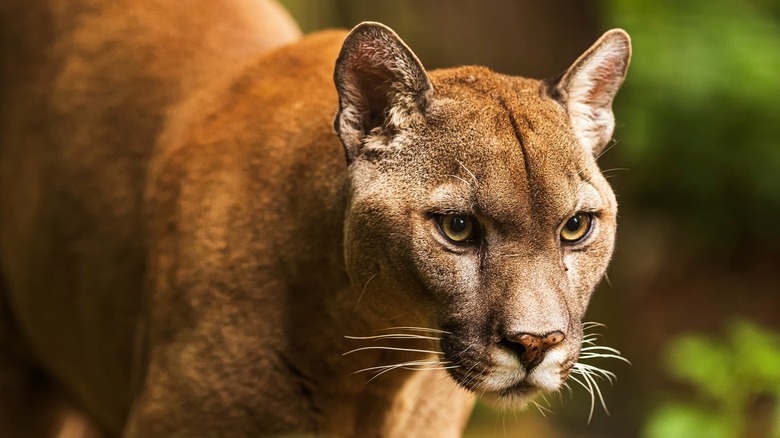Warning Signs That A Mountain Lion Is Nearby
Mountain lions, also known as cougars or pumas, have been making headlines recently for their encounters with humans — and because of this, the public fear of these apex predators has been growing. This makes sense because these big cats are experts in stealth, climbing, and stalking. However, despite being large and skillful predators, attacks from mountain lions on humans are quite rare. In fact, according to the Mountain Lion Foundation, even encountering these animals in the wild is very unlikely because they are more scared of us than we are of them and prefer to avoid people.
However, as ABC News notes, despite the mountain lions' desire to avoid us, accidental meetings between humans and these big cats have increased in recent years due to the growth of the lion population from successful conservation efforts, the increased popularity of outdoor activities like hiking and biking, and habitat overlap. So, even though you will likely never encounter a mountain lion, it's a good idea to understand the signs of their presence so that you will be aware if one is nearby.
The most obvious signs are footprints and scat
When mountain lions are in the area, the two main ways you will be able to tell are through the presence of footprints and scat. However, the problem is that mountain lion footprints and poop can look very similar to that of other animals.
The main way to tell whether or not an animal track belongs to a mountain lion is by looking at the shape of the main footpad. Mountain lion pawprints have three lobes or ridges on the bottom of the main footpad while prints that belong to dogs, wolves, or coyotes will only have two lobes. Bobcat tracks will be similar in appearance to mountain lion tracks, but much smaller. A mountain lion's footprint is often around four inches long while a bobcat's is typically around one and a half inches.
Seeing scat (or animal droppings)is another way to tell that a mountain lion is in the area. Mountain lions often mark their territory with scat, and you may find their droppings in obvious locations like in the middle of a trail or on top of a pile of dirt. Mountain lion scat is typically around one inch in diameter. The fresher the droppings, the higher the likelihood that the animal that made it is nearby.
Partially buried or eaten prey
Another sign that a mountain lion is probably close by is a partially eaten animal. Mountain lions most commonly hunt deer but have also been known to kill elk, raccoons, wild hogs, coyotes, and porcupines. These big cats will often not finish an entire kill in one sitting and will instead drag the carcass into their territory and partially bury it to save the rest of the meat for later. So, if you find a partially buried and eaten deer in the forest, you are probably in a mountain lion's territory.
If you happen upon a freshly killed animal, that means that the big cat is likely very close by and was only temporarily scared off by you. In this situation, the best course of action is to leave the area from the way you came and warn others to avoid the trail to give the lion enough time and space to safely drag its kill away.
Look out for scratch marks and scent piles
Mountain lions like to operate within a range or territory to avoid conflict with other predators. According to The Humane Society, these territories can be anywhere from 30 to 125 square miles and are typically well-marked with scents and other signs to both warn off and communicate with other cats.
The main way that a mountain lion will mark its territory is through scratch piles. To do this, the lion will claw at the ground to create a pile of dirt or leaves and then urinate on top of the pile. They may also leave scat on top of the pile as another scent marker. These piles are typically found around the borders of a male mountain lion's territory and near kill sites.
Another less common way that mountain lions mark their territory is by scratching trees and fallen logs. While the main reason the cats do this is likely to sharpen their claws, many researchers also believe that they use this practice to leave a scent behind and mark territory. However, just scratch marks on a tree is not enough to confirm the presence of a cougar as other animals, including bears, also participate in this behavior.
Pay attention to the behavior of other animals
When hiking with dogs, it is usually recommended to avoid areas that are known to contain mountain lions because dogs look quite similar to coyotes and may draw lions closer to investigate. However, if you do bring your pet with you on your outdoor adventure and they begin acting skittish, nervous, or aggressive, this is a sign that a predator is nearby. Dogs have sharper senses than humans and are often able to smell a mountain lion and register its presence before we do.
If this happens, you should keep your dog close to you and on its leash. The leash will prevent your dog from possibly running off after a mountain lion and will also make sure the mountain lion sees you next to the dog. Your proximity to the dog will likely stop the mountain lion from getting any closer. However, you should still back away and leave the area to ensure the safety of your pet.
How to avoid a mountain lion encounter
If you spend time outdoors in areas with mountain lions, there are a few simple ways to avoid them. The first is to make your presence known when outside. As mentioned previously, mountain lions actively avoid people. So, if they know you are around, they will likely give you plenty of space. While hiking, a good way to make your presence known is to clap, talk, or sing while walking. You can also purchase a whistle or horn to scare any nearby big cats away.
It is also a good idea to hike, bike, or run outdoors in groups because mountain lions are much less likely to attack or approach multiple people. You should also try to schedule your outdoor activities during the daylight and avoid the big cat's most active hours, which include any time at night or during sunset and sunrise.
Lastly, it is important to keep an eye out for signs of a mountain lion's recent presence such as fresh prints, scat, or kills. If you see a mountain lion (even if it's in the distance) or notice any fresh signs that one is nearby, you should leave the area and notify anyone else on the same trail of the big cat's location as you do.





